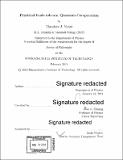Practical fault-tolerant quantum computation
Author(s)
Yoder, Theodore J
DownloadFull printable version (21.08Mb)
Other Contributors
Massachusetts Institute of Technology. Department of Physics.
Advisor
Isaac L. Chuang.
Terms of use
Metadata
Show full item recordAbstract
For the past two and a half decades, a subset of the physics community has been focused on building a new type of computer, one that exploits the superposition, interference, and entanglement of quantum states to compute faster than a classical computer on select tasks. Manipulating quantum systems requires great care, however, as they are quite sensitive to many sources of noise. Surpassing the limits of hardware fabrication and control, quantum error-correcting codes can reduce error-rates to arbitrarily low levels, albeit with some overhead. This thesis takes another look at several aspects of stabilizer code quantum error-correction to discover solutions to the practical problems of choosing a code, using it to correct errors, and performing fault-tolerant operations. Our first result looks at limitations on the simplest implementation of fault-tolerant operations, transversality. By defining a new property of stabilizer codes, the disjointness, we find transversal operations on stabilizer codes are limited to the Clifford hierarchy and thus are not universal for computation. Next, we address these limitations by designing non-transversal fault-tolerant operations that can be used to universally compute on some codes. The key idea in our constructions is that error-correction is performed at various points partway through the non-transversal operation (even at points when the code is not-necessarily still a stabilizer code) to catch errors before they spread. Since the operation is thus divided into pieces, we dub this pieceable fault-tolerance. In applying pieceable fault tolerance to the Bacon-Shor family of codes, we find an interesting tradeoff between space and time, where a fault-tolerant controlled-controlled-Z operation takes less time as the code becomes more asymmetric, eventually becoming transversal. Further, with a novel error-correction procedure designed to preserve the coherence of errors, we design a reasonably practical implementation of the controlled-controlled-Z operation on the smallest Bacon-Shor code. Our last contribution is a new family of topological quantum codes, the triangle codes, which operate within the limits of a 2-dimensional plane. These codes can perform all encoded Clifford operations within the plane. Moreover, we describe how to do the same for the popular family of surface codes, by relation to the triangle codes.
Description
Thesis: Ph. D., Massachusetts Institute of Technology, Department of Physics, 2018. Cataloged from PDF version of thesis. Includes bibliographical references (pages 190-201).
Date issued
2018Department
Massachusetts Institute of Technology. Department of PhysicsPublisher
Massachusetts Institute of Technology
Keywords
Physics.